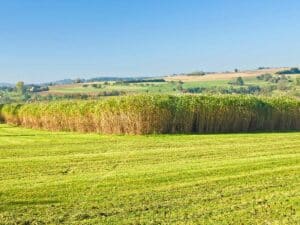Author: Edward Hodgson
94% of Farmers growing miscanthus report benefits to their farm business according to results of a survey published in the GCB Bioenergy journal. The survey was conducted on 17 farms in England and Wales to assess the benefits and drawbacks of growing the bioenergy crop miscanthus in the UK.
The farms surveyed had converted areas of their farms from a mix of arable and pasture land to miscanthus supplied by the UK-based company Terravesta. The majority of those surveyed reported benefits in terms of improved profit margins due to reduced work-load, the reduced need for hired labour and the lower input and maintenance requirement of the crop. The crop was reported to grow particularly well on wet heavy soils and was found to help reduce soil erosion when planted on sandy soils. The Miscanthus stands were found to make better use of smaller, odd shaped fields or those with obstructions due to the lack of requirement for using larger equipment such as spray-booms. Farmers surveyed reported that reduced requirement for spraying was also seen as beneficial when miscanthus was planted on land adjacent to dwellings and recreation areas; reduced need for fertiliser reduces likelihood of leaching/runoff, which is especially important for farms in nitrogen sensitive catchment areas.
At present, some long-term supply contracts are available from companies which assist with establishment and link production with end-user power stations within a 50 mile radius, for example Terravesta have a 15 year supply contract with Snetterton and Brigg power stations. These longer-term contracts were considered by survey respondents as helpful in encouraging uptake and spreading financial risk. High transportation costs prohibited supply of material beyond the local area and a need for more diversified markets was highlighted along with greater provision of information regarding the long-term benefits of miscanthus and to build trust in the crop. These were perceived as major issues that were discouraging farmers from entering the market. However, 71% of farmers surveyed stated they would consider expanding their miscanthus planted area in the future.
The farmers surveyed highlighted several measures which could be taken to improve confidence and uptake of miscanthus as a mainstream crop in the UK:
- More information regarding the agronomy and the long-term benefits to soil health.
- A greater selection of planting stock to match different soil conditions
- Recognition and monetisation of the crops utility in terms of carbon sequestration/storage.
- More incentives or subsidies in the form of annual planting grants or payments at harvesting to offset establishment costs and reduce the financial risk.
- Market creation and diversification – more outlets for the biomass produced and stimulation of existing local markets.
- Higher bale prices and less complicated price calculations.
- A larger selection of planting stock that can ensure higher yields on a wider range of soil conditions and farm locations.
The overall perception was that the UK market was not quite ready for large-scale Miscanthus operations but this could all be set to change. The BEIS funded Biomass Feedstocks Innovation Projects are designed to tackle knowledge gaps around biomass crops and 2023 will see both the full details of the revised Environmental Land Management Schemes (ELMS) and the new Biomass strategy. To what extent these schemes will help address the barriers to uptake of miscanthus and other energy crops remains to be seen.




